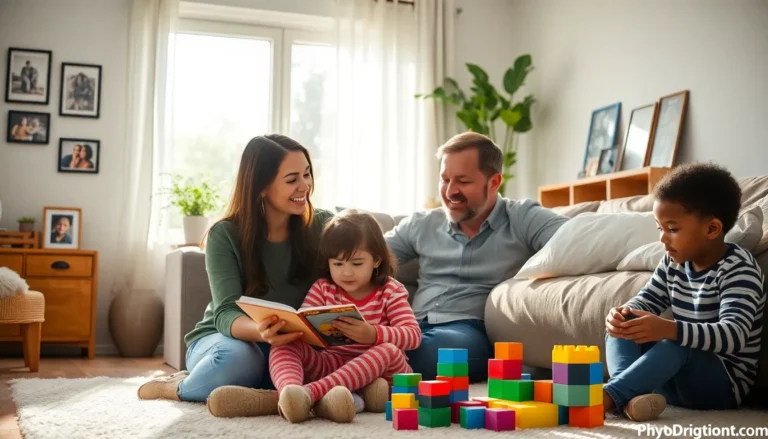In a world where stress seems to be the new normal, teaching coping strategies is like handing out life jackets in a sea of chaos. Everyone’s trying to stay afloat, but without the right tools, it’s easy to feel like they’re just treading water. Whether it’s a sudden wave of anxiety or the everyday grind, having effective coping strategies can turn potential shipwrecks into smooth sailing.
Imagine a classroom where students aren’t just learning math and science but are also mastering the art of emotional resilience. With the right techniques, they can tackle challenges with confidence and maybe even crack a smile while doing it. It’s time to equip the next generation with the skills to navigate life’s storms, all while keeping their sense of humor intact. After all, who said coping strategies can’t come with a side of laughter?
Table of Contents
ToggleUnderstanding Coping Strategies
Coping strategies are essential tools for managing stress and navigating life’s challenges. They provide individuals with methods to handle difficult emotions and situations effectively.
Definition and Importance
Coping strategies refer to the techniques and skills individuals use to manage stressors and emotional challenges. These strategies play a crucial role in emotional resilience. Learning effective coping mechanisms can significantly reduce anxiety and improve mental health outcomes. Research shows that individuals who employ coping strategies experience lower levels of stress and higher life satisfaction. Teaching these methods in educational settings equips students with the ability to face obstacles confidently, fostering a generation that approaches difficulties with a positive outlook.
Types of Coping Strategies
Coping strategies can be divided into two main categories: problem-focused and emotion-focused strategies. Problem-focused strategies aim to address the source of stress directly. Examples include time management, seeking support, and problem-solving techniques. Emotion-focused strategies focus on managing emotional responses. These include mindfulness practices, deep breathing exercises, and engaging in leisure activities. Each category offers unique benefits, allowing individuals to choose the most suitable approach based on their needs and circumstances. Understanding these types empowers individuals to apply the right strategy for different situations.
The Role of Educators
Educators play a crucial role in teaching coping strategies to students. They can assess each student’s unique needs and implement appropriate support systems.
Identifying Students’ Needs
Recognizing individual needs involves active observation and communication. Teachers must engage with students to understand their emotional challenges and stressors. Regular check-ins provide insight into their struggles. Utilizing assessments and feedback, educators can tailor strategies that resonate with specific situations. Customizing interventions ensures that all students benefit from effective coping mechanisms. This proactive approach strengthens students’ resilience and promotes their emotional well-being.
Creating a Supportive Environment
Establishing a supportive learning atmosphere greatly enhances students’ coping abilities. Encouragement and validation from educators foster trust and openness. Collaborative activities enable students to share their experiences and feelings freely. Including mindfulness practices in the daily routine can create an atmosphere of calmness. Integrating relaxation techniques, such as deep breathing exercises, helps students before stressful situations. This nurturing environment equips students with the necessary tools to manage stress and anxiety effectively.
Effective Methods for Teaching Coping Strategies
Teaching coping strategies effectively requires engaging methods suited to students’ diverse needs. Interactive activities emphasize hands-on learning while fostering collaboration. Students can participate in role-playing scenarios that simulate stress-inducing situations, allowing them to practice responses in a safe environment. Group discussions stimulate dialogue, encouraging peers to share their experiences and coping techniques. Art and music can also play a role; creating projects expresses feelings and reinforces emotional release.
Incorporating technology further enriches the learning experience. Apps designed for mental health support offer guided relaxation exercises and mindfulness practices. Online forums provide platforms for students to connect and share coping strategies, building a supportive community. Virtual reality experiences can simulate stressful situations, helping students practice coping techniques in realistic settings. By blending traditional methods with modern technology, educators ensure students gain essential coping skills tailored to the current challenges they face.
Challenges in Teaching Coping Strategies
Teaching coping strategies involves navigating various challenges that may hinder effective learning. Understanding these obstacles allows educators to tailor their approaches for better outcomes.
Common Barriers
Students often face common barriers when learning coping strategies. One barrier involves lack of awareness about their emotional needs. Many students may not recognize the importance of coping skills until they experience significant stress. Limited access to resources also affects learning; schools with fewer mental health resources struggle to provide adequate support. Additionally, cultural factors can influence perceptions about discussing emotions. In some environments, sharing feelings might be stigmatized, leading to resistance. These obstacles can create an environment where coping strategies remain underutilized.
Overcoming Resistance
Overcoming resistance requires strategic engagement from educators. Building trust is crucial; when students feel safe, they’re more likely to open up. Educators can initiate conversations about emotions through normalizing discussions in the classroom. Another effective approach involves incorporating relatable scenarios, showcasing coping strategies in real life. Providing examples helps demonstrate the effectiveness of these techniques. Additionally, offering choices in activities allows students to select methods that resonate with them personally. This personalized approach fosters ownership of their coping skills, breaking down barriers and encouraging active participation.
Conclusion
Teaching coping strategies is vital for fostering emotional resilience in students. By equipping them with the tools to manage stress and navigate challenges, educators can help cultivate a generation that approaches life with confidence and positivity.
Creating a supportive environment where emotional discussions are normalized encourages students to actively engage in their learning. The integration of diverse teaching methods ensures that coping strategies resonate with individual needs, making the learning process both effective and enjoyable.
As students develop these essential skills, they’re better prepared to face life’s uncertainties, leading to improved mental well-being and overall life satisfaction. Investing in their emotional health today will yield benefits that last a lifetime.






